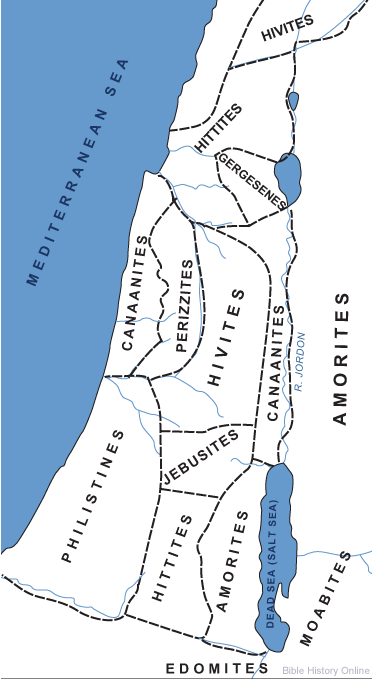Below the totals above is illustrated another way of translating the
results of the censuses. The most frequently suggested
alternate is that the Hebrew word translated as "thousand" in these
population
figures actually refers to an indeterminate-size clan, troop or family.
The Hebrew word itself is
transliterated 'elep (Strong's number 505 or 504) and also carries the
meaning of a family
complex or clan in some cases, such as family (KJV)(ASV)(RV)(NAB)(LITV)
and clan (AAT)(GNB)(CEV) in Judges 6:15.
Also translates in Numbers 1:16 as family (BER), clans (AAT) (ESV) and
troops (NAB). And also in I Samuel 10:19 translated as families
(LITV)(CEV)(GW), clans (JERUS) and in I Samuel 23:23 clans (CEV)(JERUS),
families (GW), divisions (MOF), and
multitudes (KNOX).
Decoding the Census Numbers:
Numbers 1:2-3 (ESV) gives the instructions:
"Take a census of all the congregation of the people of Israel,
(a) by clans (tribe),
(b) by fathers' houses (household, families),
(c) according to the number of names, every male, head by head.
From twenty years old and upward,
all in Israel who are able to go to war,
you and Aaron shall list them, company by company."
Numbers 1:18 (ESV) again tells us when and how the census was conducted:
"and on the first day of the second month,
they assembled the whole congregation together,
who registered themselves (they declared their pedigrees according to their families)
(a) by clans (tribe),
(b) by fathers' houses (household, families),
(c) according to the number of names from twenty years old and upward, head by head, "
Therefore, we should expect the census data to contain the following information;
(a) tribe,
(b) family,
(c) number
for every male older than twenty who is able to fight !!
Using Reuben, the first born as the example ;
Num 1:20 (LITV)
And the sons of
(a) Reuben, Israel's first-born,
(b) their generations by their families, by their fathers' house,
(c) in the number of names, by their heads, every male from a son of twenty years and upward, everyone able to go out to war:
Num 1:21 those numbered of them for the
(a) tribe of Reuben were
(b) forty six families and
(c) five hundred (men).
So What is the Total Population Implied by the Alternate Translations ?
The results for the first census adds up to 598 families or troops
consisting of a total of 5550 men and the results for the second census
is nearly the same at 596 families or troops consisting of 5730 men.
This could possibly put the total population including women and
children at somewhere between 20,000 to 40,000 and also much more in
alignment with they being the less numerous of all the nations in the
area !!
The population total resulting could seem to be low on the basis of the
Scriptural reports of the number of people killed in various events
during the time of the journey. For example, Num. 16:49 tells of a
plague that killed 14,700, and Num. 25:9 tells of another plague killing
24,000. In the New Testament, 1 Cor. 10:8 tells of 23,000 being killed
in one day, presumably in the incident of the golden calf. (The total
number who died at this time is not recorded in the Old Testament.) Thus
these three events account for more than 50,000 deaths, which seems
quite large if the total population was only about 20,000 to 40,000.
However, this does not mean that this view is impossible. In the first
place, the 23,000 killed in the incident of the golden calf was before the first census was taken.
It is possible that the original population was around 40,000 or more,
and only around 20,000 to 30,000 were left for the first census. The
population could have increased during the first part of the 40 years of
wandering, only to be reduced again by the aforementioned plagues. Also
note that they were accompanied in the exodus by a mixed multitude of
unspecified size (Ex. 12:38). It is possible that the death tolls
recorded included a significant portion from among this mixed multitude
who were not included in the census.
The other possible explanation is that the individuals counted in the
censuses were men who were not part of any clan. Thus, the first census
would add up to 598 clans of unspecified size and 5550 additional men.
Then the actual number of men would be left unspecified. This may be a
legitimate alternative, but it certainly seems like a strange way to
conduct a census, especially in light of the Scriptural description of
the process as "Lift the heads of all the congregation of the sons of Israel, by their families, by their fathers' houses, according to the number of names, every male, by their heads;"
(Num. 1:2 LITV). So this method is not considered!
Further Advantages of this View !
The assumption that Israel's population during the exodus was only
around 20,000 to 40,000 instead of two million or more greatly
simplifies the explanation of a number of difficult Scriptures. Some of
them are discussed below:
The account of the conquest of Jericho would be hard to explain from a
logistical point of view if the army of Israel numbered 600,000.
Jos 6:3 "And you shall go around the city, all the men of war."
The city would have been totally surrounded by the 600,000 men, unless
it were many miles in circumference. But if it was that big, then how
could the men march around it 7 times in one day? This problem is even
more significant if we accept the archaeological findings that the walls
of Jericho encompassed an area of only about 8½ acres, per research
cited in The New Unger's Bible Dictionary (Moody, 1966, p. 672).
Or less than a one mile walk depending upon how far they stayed away
from the walls of the city. This is a much more reasonable fit for
around 6000 to 10,000 men than 600,000.
In numerous places, Scripture speaks of the whole congregation of Israel
listening to Moses or Aaron (e.g., Ex. 16:10, 35:1, Lev. 19:2, Num.
20:8, cf. Josh. 8:35), or gazing at Moses (Ex. 33:8), or assembling at
the doorway of the tent of meeting (Num. 16:19). This is hard to fathom
for a population of around two million, but probably plausible for a
population of around 20,000 to 40,000.
In the incident of the golden calf, Moses instructed every man of the
Levites to execute God's vengeance with the sword (Ex. 32:27). This they
faithfully did (Ex. 32:28-29), and they ended up killing a total of
3000 people. If the tribe of Levi consisted of tens of thousands of men
of fighting age, this seems like a rather small total assuming "every
man" of them really did as he was told. But if the tribe of Levi
consisted of only a few hundred men of fighting age to begin with, then
it makes reasonable sense.
Number of Levites at the first Census (Numbers 3:21-39)
(The numbers below refer to the number of Levite males over 1 month old)
Numbers if | Numbers if 'elep = families | males
Tribe 'elep = 1000 | # of families | # of males | per family
Gershon 7,500 7 500 71
Kohath 8,600 8 600 75
Merari 6,200 6 200 33
Total 22,300 21 1300 48
Note;
In verse 3:39 the Levites in most translations are listed as 22,000 and
300 seem to be missing.
Since the total of families is 21, this 22,000 represents 21 families
and 1000 males.
In the Talmud and also The Bible Knowledge Commentary, 1985, Victor
Books, p. 220, it is pointed out that
the 300 were the firstborn Levites and who could not serve to redeem the
firstborn males of Israel. This number of 300 firstborn
of the tribe of Levi also indicates that there could not be a total of
22,300 since this would mean that only about one in 74 would be
firstborn !
But, 300 firstborn for a total of 1300 would be about one in 4.3, a very
reasonable number !
In Num. 20:17, Israel requested permission of the Edomites to travel
through their land, promising to stay on a certain highway. The same
request is made to the Amorites in Num. 21:22. If the population of
Israel was around two million, how could they possibly travel through on
a single highway, along with all their possessions? Even if they could
go 10 abreast with only 10 feet between groups, the line would stretch
out for nearly 400 miles! This would be a difficult enough task even for
a population of only around 20,000 to 40,000. It seems utterly
inconceivable for a population of around two million.
Conclusion:
We have presented the best estimates of those that study ancient populations, and shown an alternate
interpretation of the populations of the exodus, and illustrated how these much smaller estimates
of around 20,000 to 40,000 are
more in line with they being "the fewest of all people"
and with a number of other verses that give clues for a much smaller population than
the estimate of 2 million or more made by many well meaning scholars.
from Strong's Hebrew Dictionary http://www.htmlbible.com/sacrednamebiblecom/kjvstrongs/STRHEB5.htm
504 'eleph eh'-lef
from ''alph' (502); a family; also (from the sense of yoking or taming) an ox or cow:
--family, kine, oxen.
505 'eleph eh'-lef
prop, the same as ''eleph' (504); hence (the ox's head being the first letter of
the alphabet, and this eventually used as a numeral) a thousand:--thousand.




